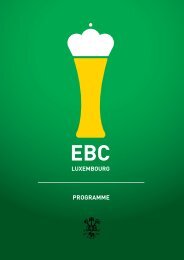here - the 34th European Brewery Convention
here - the 34th European Brewery Convention
here - the 34th European Brewery Convention
Create successful ePaper yourself
Turn your PDF publications into a flip-book with our unique Google optimized e-Paper software.
P34<br />
Yeast biodiversity as a tool for flavor improvement in beer<br />
Catrienus de Jong 1 , Amparo Gamero 1 , Michael Katz 2 , Zoran Gojkovic 2<br />
1 NIZO food research, Ede, Ne<strong>the</strong>rlands, 2 Carlsberg Group, Copenhagen, Denmark<br />
During <strong>the</strong> brewing process, Saccharomyces species contribute to beer aroma development, but<br />
hundreds of o<strong>the</strong>r poorly studied yeast species exist, being an underutilized resource with potential for<br />
product innovation. MicroBeer is a miniaturized brewing process (5 ml) highly useful for screening<br />
purposes. In this study, twelve strains presenting high potential for aroma formation were tested in<br />
pure and mixed culture at 12°C. The results of <strong>the</strong> MicroBeer pointed out problems in maltose<br />
utilization and masked aromas in mixed cultures. These problems were solved in <strong>the</strong> lab-scale<br />
fermentations employing enzyme-treated wort and lower proportions of Saccharomyces yeast. This<br />
was a clear example of <strong>the</strong> usefulness of <strong>the</strong> microsystems to screen different conditions as a tool for<br />
improvement. In addition, some yeasts were able to produce high amount of esters, which could mean<br />
a potential increase in beer fruitiness and some yeast combinations result to be useful for flavor<br />
improvement.<br />
P35<br />
Characterisation of fresh and aged single-hop beers via hop oil constituents fingerprinting and<br />
sensory assessment<br />
Filip Van Opstaele 1 , Ann Van Holle 2 , Jan Van Nieuwenhove 2 , Dirk Naudts 2 , Denis De Keukeleire 3 ,<br />
Guido Aerts 1 , Luc De Cooman 1<br />
1 KAHO Sint-Lieven University College, KU Leuven Association, Ghent, Belgium, 2 De 'proef'brouwerij,<br />
R&D department, Lochristi, Belgium, 3 Em. Prof., Ghent University, Ghent, Belgium<br />
The focus of this study is on scrupulous investigation of hop oil constituent fingerprints of fresh and<br />
aged single-hop beers aromatised with particular hop varieties using late and dry hopping techniques.<br />
The results clearly reflect analytical and sensorial differences between fresh late and dry-hopped<br />
beers produced with <strong>the</strong> same hop variety on <strong>the</strong> one hand and between single-hop beers aromatised<br />
with different varieties on <strong>the</strong> o<strong>the</strong>r hand. Upon ageing a significant decrease of <strong>the</strong> level of hop oil<br />
esters and terpene hydrocarbons was observed for all beers. Our results point to adsorption of<br />
volatiles at <strong>the</strong> haze formed upon ageing and adsorption of particular volatiles at <strong>the</strong> crown liners. Hop<br />
oil volatiles belonging to <strong>the</strong> ester and monoterpene hydrocarbons group always decrease to a higher<br />
extent in dry-hopped beers. Sensorial data show that <strong>the</strong> fresh flavour of dry hopped beers is less<br />
stable compared with <strong>the</strong> corresponding late hopped beers investigated in this study.<br />
P36<br />
From wort to beer: The evolution of hoppy aroma of single hopped beers produced by early<br />
kettle hopping, late kettle hopping and dry hopping<br />
Michael Dresel 1 , Tatiana Praet 1 , Filip Van Opstaele 1 , Ann Van Holle 2 , Jan Van Nieuwenhove 2 , Dirk<br />
Naudts 2 , Denis De Keukeleire 3 , Guido Aerts 1 , Luc De Cooman 1<br />
1 KAHO Sint-Lieven University College, KU Leuven Association, Laboratory of Enzyme, Fermentation<br />
and Brewing Technology, Ghent, Belgium, 2 De 'proef'brouwerij, R&D Department, Lochristi, Belgium,<br />
3 Em. Prof., Ghent University, Ghent, Belgium<br />
Knowledge of <strong>the</strong> impact of early kettle, late kettle and dry hopping on <strong>the</strong> final flavour sensation of<br />
beers is ra<strong>the</strong>r fragmentary. To gain insights into <strong>the</strong> way hoppy aroma develops, samples were taken





